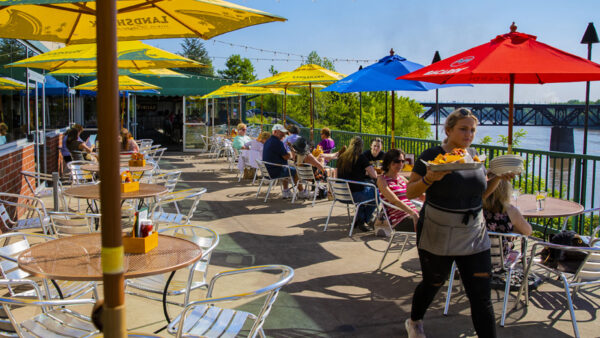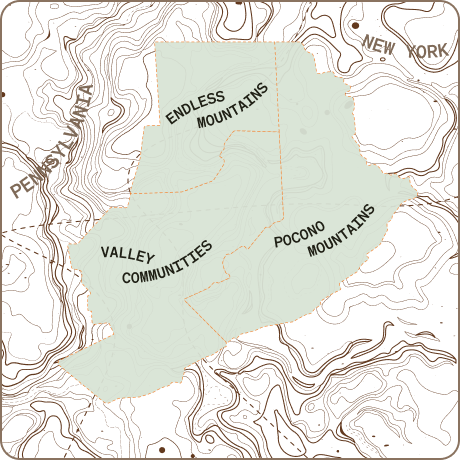Timber Sale Resulted in Clearing Nearly 300 Acres of Trees in Delaware State Forest

Last Friday, the PA Department of Conservation & Natural Resources hosted a Walk and Talk event to promote public awareness for the Bureau of Forestry’s Ambush Timber Sale. We gathered at a recently graded parking area of the Delaware State Forest on White Deer Lake Rd. in Hawley. Our small, conservation-minded group huddled from the wind around a few parked cars, a box of complimentary coffee and homemade cookies.
The “Talk” portion opened with a presentation by Tim Dugan, PA DCNR District Forester for the Delaware State Forest and Management Forester, Eric Kuntz. They discussed the standard timber sale procedures of the PA DCNR’s State Forest Resource Management Plan. In total, 295 acres of forest were cleared for the sale.

After coffee, cookies and discussion, the foresters led the group on a guided walk over the cleared portion of the forest. Management Forester, Eric Kuntz explained the net positive environmental impact of regular timber sales. “Allowing these 295 acres to breathe and opening them up to sunlight allows for almost immediate regrowth,” said Kuntz. “They just finished clearing this ground about a week ago and, if you look closely, you’ll already see so many small oaks sprouting.” According to Kuntz, most of the cleared ground will be allowed to regrow naturally while a few small sections may require targeted seeding.

The timber sale program employs a scientific, balanced approach. Kuntz personally walked every inch of the proposed lot and hand selected areas for harvest and specific trees to save. The timber harvest clears out old growth, promoting ideal conditions for a whole new forest to flourish.
The Walk and Talk series is part of the Delaware State Forest District’s Activity Plan, which is designed to engage the public regarding management activities, projects and events taking place on forest lands.
The Economic Role of Timber Sales

Pennsylvania’s Bureau of Forestry sells over 70 million board feet of timber annually. They conduct up to 180 sales every year throughout the 2.2. million-acre state forest system. All told, the timber sales help to fuel the $19 billion statewide lumber and forest product industry. The program also benefits PA consumers by providing locally-sourced, competitively-priced forest products. And, according to District Forester, Tim Dugan, the timber management program and the products it directly influences is a major economic driver for the state.
“The resources that we’re selling, the timber, is being purchased by private entities and there’s a whole food chain, so to speak, that relies on that industry.” He continues, “From truckers to loggers to maintenance repair people to the wood mills and the shops that use the wood products, it all contributes to the economy both locally and statewide.”

Dugan also explains that the revenue generated through timber sales makes its way back into the state forest system. “10% of that revenue is reserved into our regeneration fund for use only on state forest land. It goes directly into helping to regenerate future forests.” The remainder enters the Commonwealth’s General Fund where it’s used to offset the budget for the Bureau of Forestry and DCNR. “Essentially, that means there are fewer taxpayer dollars directly funding us and our work,” Dugan added.
The Conservation Benefits of Timber Harvesting on Public Lands

Economic benefits aside, there’s an even greater plan at work with the Bureau’s Timber Management Plan. “The long-term goal for our state forest lands is to continue to have healthy forests here for people to enjoy now, but most importantly in the future,“ Dugan stated. In short, regularly harvesting timber actually goes a long way toward long-term sustainability. The cleared acreage promotes regrowth on a large scale. It helps with efforts in pest management, protecting and sustaining threatened wildlife and assisting in water quality protection. According to Dugan, selling the timber is a small benefit. “What we’re really doing here is ensuring that new trees are replacing anything we take out, and we’re regrowing healthier forests for the long term.”

In all, the Walk and Talk lasted roughly three hours. We learned. We got outside. We enjoyed a morning hike through the Delaware State Forest, and we had a chance to see a part of the forest management system that we’d normally never see. For Dugan, that’s precisely what this series is all about. “We want to provide an opportunity for the public and our stakeholders to see this process up close.” And while timber harvests and sales are not necessarily a rare occurrence on public land, Dugan believes that the public involvement in this series can help to educate and alleviate any concerns. He concludes, “When someone sees a timber harvest on state forest land, we want them to know that there’s a lot of thought and foresight that goes into the whole process. And that there’s a great deal of science behind it.”
Learn more about forest management programs, state forest sustainability, timber sales and future Walk and Talk events at the DCNR and Bureau of Forestry websites.






























